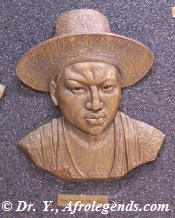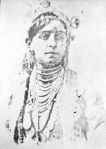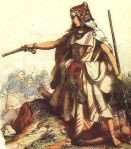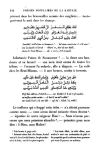
Mandume, king of the Cuanhama (Oukwanyama) principal subgroup of the Ovambo in Southern Angola, was one of the last and most important resistance leader against Portuguese conquest in Angola. By the size of his army, he could be compared to Samori Touré, but he did not have the same historic aura or military genius and given his very short life, he has remained unknown to many. Yet, in 1915, he held in his hands for 10 days the scourge of the balance of power in Southern Angola directly, and indirectly in Angola as a whole. Mandume is celebrated by many nationalists in Luanda as one of their heroes because he fought against Portuguese advances inside Angolan territory. He was a leader of the Ovambo resistance, defending the independence of his people, the Cuanhama so as not to get absorbed within Angola. Given European drawing of African boundaries during the 1884 Berlin Conference, the Cuanhama found themselves between areas of Portuguese West Africa (Angola) and German South West Africa (Namibia); thus Mandume has also entered the pantheon of the Namibian resistance. Who was Mandume?

Mandume ya Ndemufayo was a simple ethno-nationalist, who refused to be colonized and had about 35,000 to 40,000 armed fighters; more than any Angolan nationalists ever had before 1974. He took over the reins of the Cuanhama kingdom in 1911 and his reign lasted until 1917 when he died of either suicide or machine gun fire while under attack from South African forces. Ya Ndemufayo grew up during a time of significant upheaval in the Oukwanyama kingdom due to the presence of European merchants and missionaries. As King Nande’s nephew (his mother was the king’s sister), he was third in line for succession to the Kwanyama throne. To protect his life as royal child heir to the throne, Mandume had to live in various homesteads. King Nande died on 5 February 1911 and Mandume succeeded him at barely 18 years old. Immediately upon ascending the throne, he moved the royal residence to Ondjiva (now in Angola). He could be thought of as a neo-traditionalist leader, who, even though he studied in the German mission schools, he spoke German, and a bit of Portuguese, and championed the independence of his people. Strongly anti-European, he expelled Portuguese traders from Kwanyama territory to denounce price inflation. Given the great drought and famine which lasted from 1911 to 1916, Mandume issued decrees prohibiting the picking of unripened fruits to protect against droughts and the unneeded use of firearms, an important commodity obtained from European traders. Significantly, he also issued harsh penalties for the crime of rape and allowed women to own cattle, which was previously illegal. Overall, King Mandume sought to restore previous Kwanyama wealth and prosperity against a decaying system of local leadership. Ya Ndemufayo had a reputation for expelling Christians within the Oukwanyama kingdom. Numerous Christian families fled to the Ondonga kingdom of the Ovambos. Ya Ndemufayo did not favor Portuguese Roman Catholic missionaries as well as German Rhenish Missionary Society Protestants within his kingdom. In some European archives, it is said that he was a tyrant, but it is unclear whether it is European propaganda (a case of the hunter telling the story of the hunt) or reality.

Before Mandume, previous Cuanhama kings had fought valiantly against Portuguese invasion of their land, King Weyulu from 1885 – 1904, his brother King Nande (1904 – 1911); unfortunately, they all in the end saw no choice to the inevitable Portuguese colonization. Mandume rejected the idea of Portuguese colonial rule and demanded to be on equal terms with the colonial rulers in their distant capitals.

No European colonizer seriously challenged the well-organized and well-armed Ovambo kingdoms until 1915 and the beginning of World War I which coincided with a massive local drought. During the Battle of Omongwa in August 1915, ya Ndemufayo and the Kwanyama’s resisted a Portuguese attack led by Pereira de’Eça for three days. On 20 August, Mandume assembled several thousand men and attacked the Portuguese camp shouting “The land does not belong to the white[s]!”. After 10 hours of fighting, the Ovambo were forced to retreat due to a lack of supplies including the water which they had lost. In total, the Portuguese took 35 casualties and 57 wounded; while the Ovambo lost 25 and had 100 wounded. After the battle, the Portuguese also started claiming that German forces were helping the Ovambo because it was unimaginable to them that Africans were able to wage war like Europeans. Simultaneously, the South African forces peacefully conquered the portion of the Oukwanyama kingdom formerly located in German South West Africa; this was at a time when Germany lost the first world war, and thus all its African colonies. German South West Africa’s administration was taken over by the Union of South Africa (part of the British Empire) and the territory was administered as South West Africa under a League of Nations mandate. Due to losses and lack of water, ya Ndemufayo first relocated the Kwanyama capital to an area south called Oihole, and then later into South West Africa. He used the border line to conduct attacks against Portuguese who were encroaching on his old territory in Southern Angola. However his attacks of Portuguese interests from his territory in South West Africa were not appreciated by the South African authorities who summoned him to Windhoek where he refused to go. In February 1917, after ya Ndemufayo refused to submit to South African control, he died in battle against the South Africans who had mounted an attack against him. The cause of his death is disputed; South African records show his death from machine-gun fire, while oral and popular history described his death as suicide, after being wounded so he could not be taken in by enemy forces. After his death, the South African administration abolished the Kwanyama-Kingship which was only restored in 1998, after over 8 decades.

Today, Mandume Ya Ndemufayo is honored as a national hero in both Angola and Namibia. He is one of nine national heroes of Namibia that were identified at the inauguration of the country’s Heroes’ Acre near Windhoek. Namibia’s Founding President Sam Nujoma remarked in his inauguration speech on 26 August 2002 that: “It is better to die fighting than to become a slave of the colonial forces.” — These were the defiant words of one of Namibia’s foremost anti-colonialist fighters. He said these words in defiance when the combined [European] colonial forces insisted he should surrender. […] To his revolutionary spirit and his visionary memory we humbly offer our honor and respect.

The 100th anniversary of the death of Oukwanyama King Mandume ya Ndemufayo on February 2017 was attended by thousands of Namibians at Omhedi in the Ohangwena region including former Namibian presidents, where President Hage Geingob unveiled a bust of King Mandume. If you ever visit Windhoek, Namibia, make sure to walk along the street named after King Mandume, or visit the Universidade Mandume ya Ndemufayo in Angola. Please check out the article “The Legacy of legendary Oukwanyama King still vivid“, the article from The Namibian, Order out of chaos: Mandume Ya Ndemufayo and Oral History by Patricia Hayes, and lastly Les Africains Tome 8, editions J.A. p.207 (1977) to learn more about this great last resistant to Portuguese colonial advances in Southern Angola and Northern Namibia.









